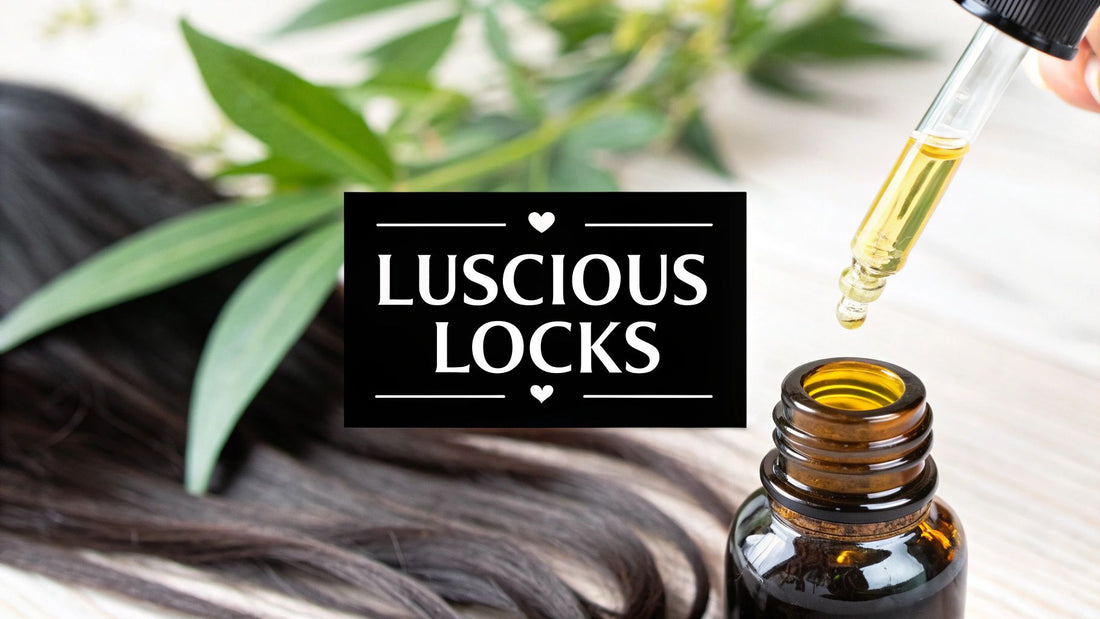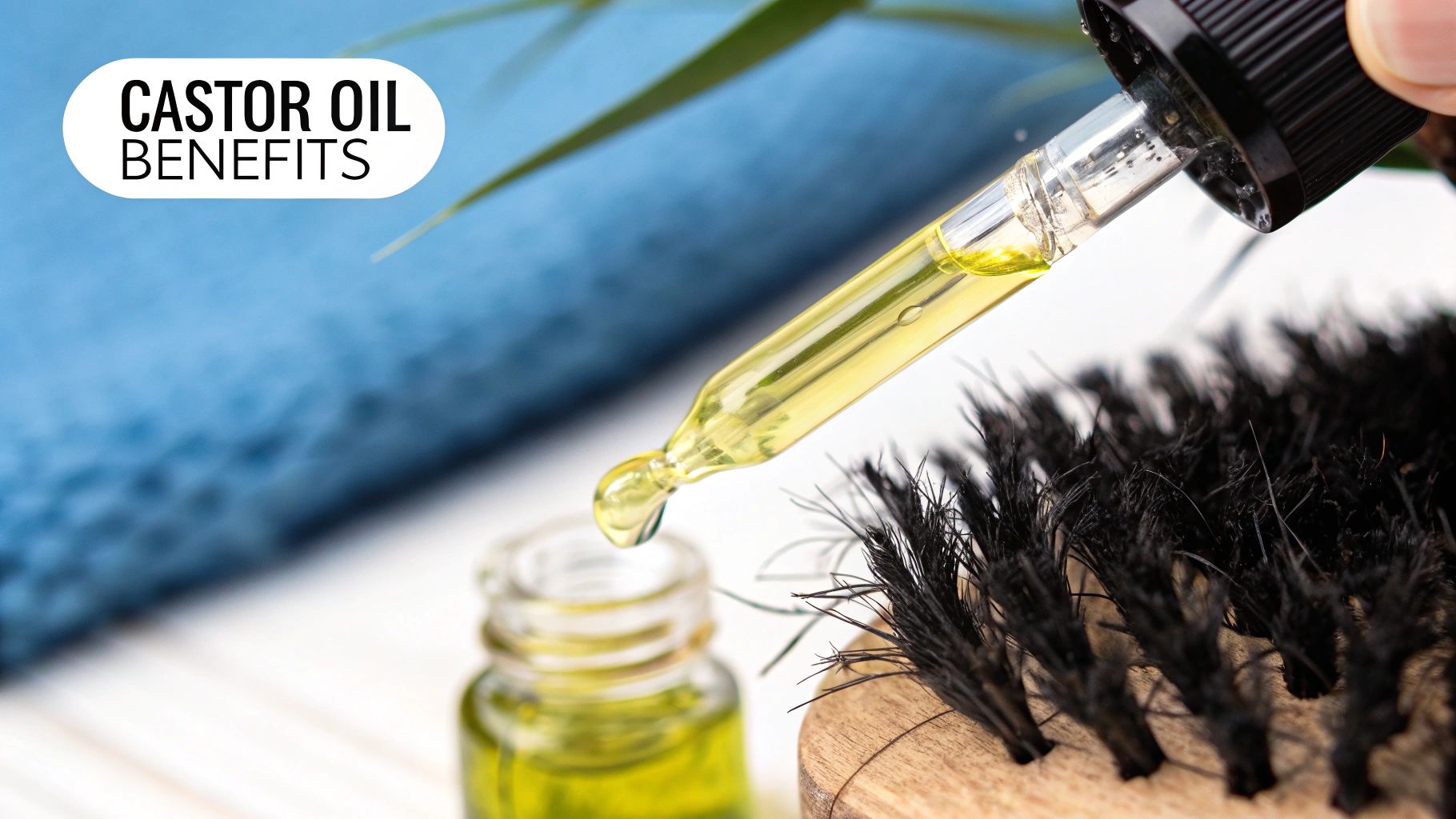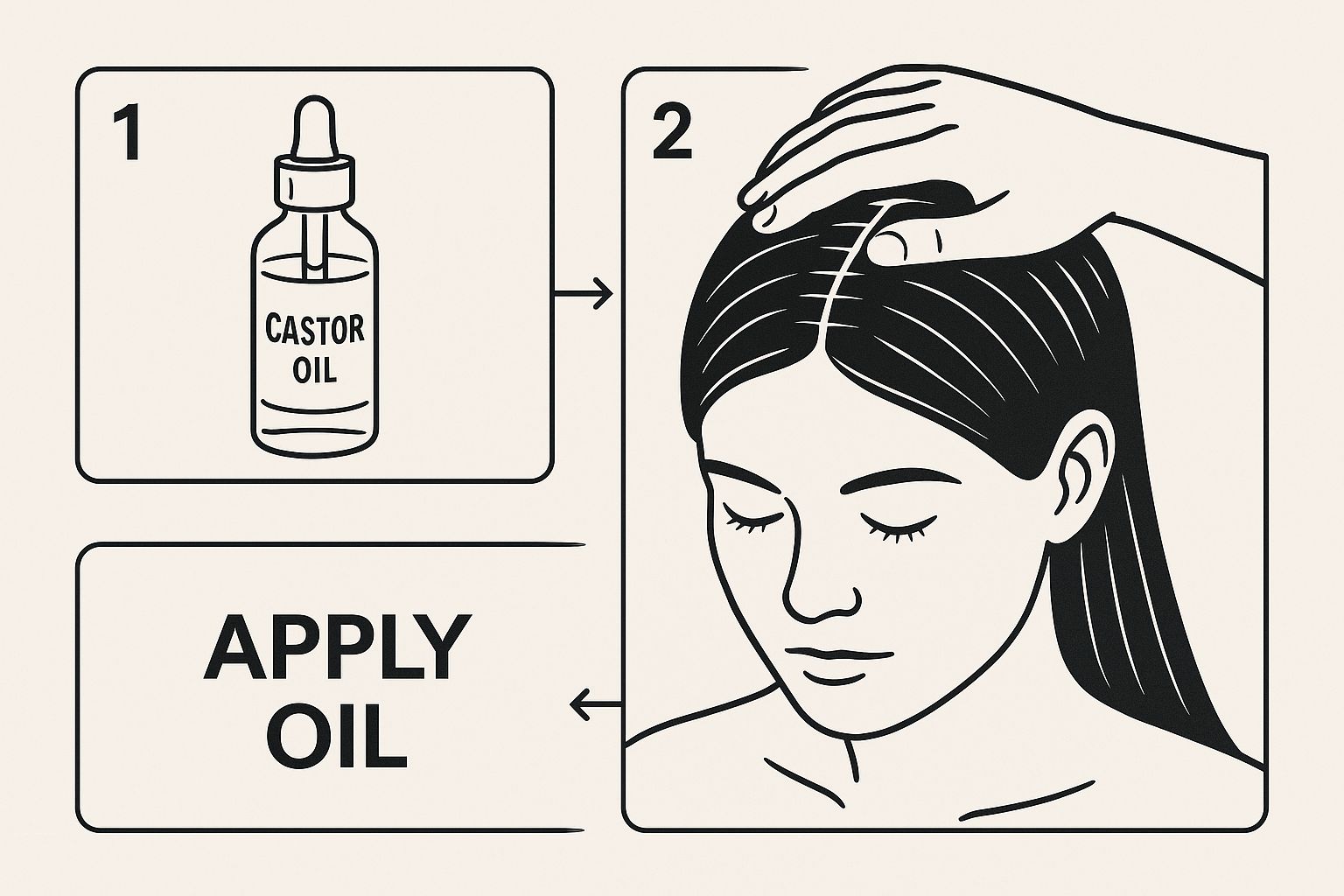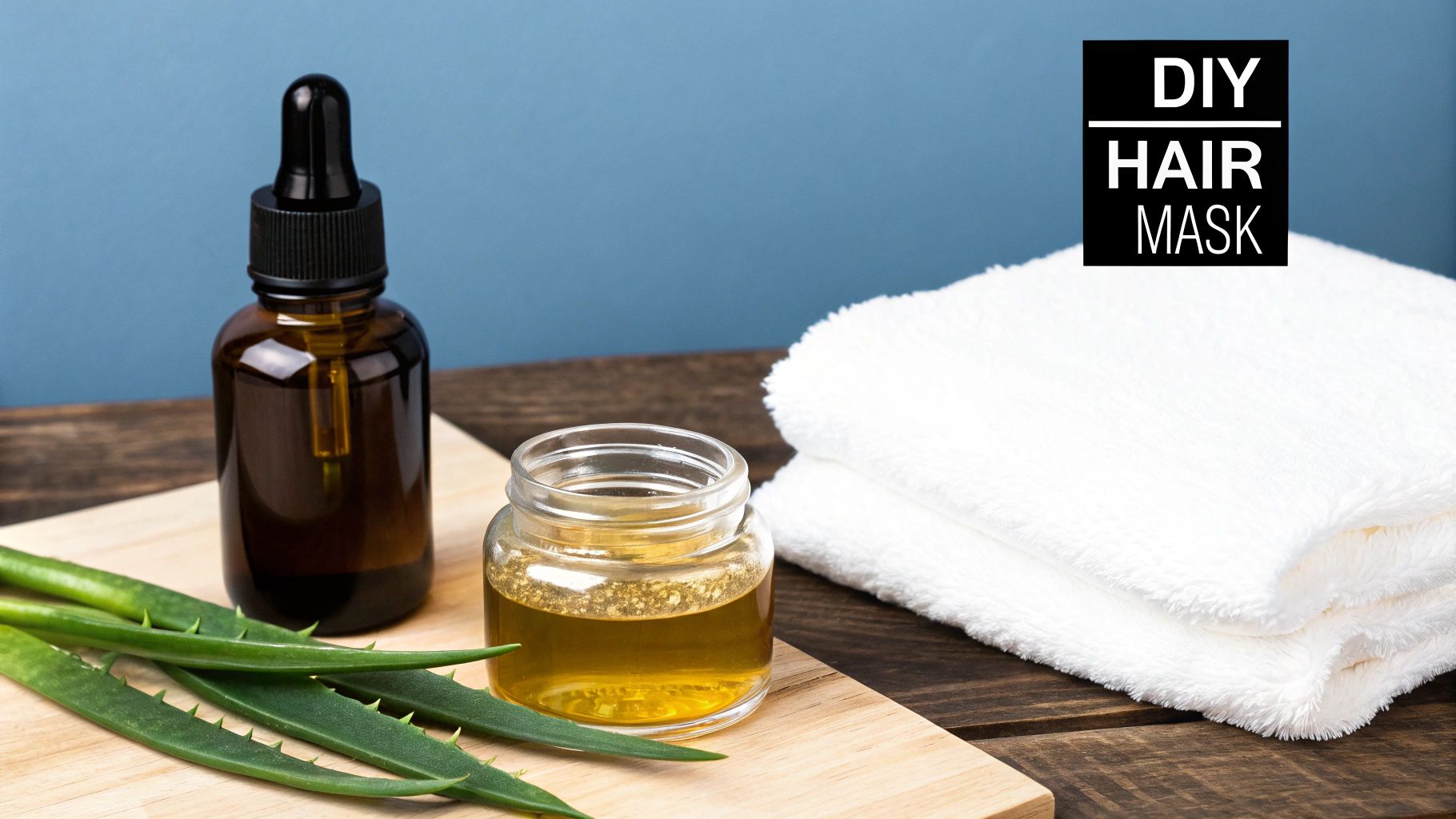
Using Castor oil for Hair Growth: Your Definitive Guide to Thicker, Shinier Hair
Share
You’ve seen the buzz online—people swearing that castor oil gave them Rapunzel-like hair. But what's the real story? Is it just hype, or can this ancient remedy truly transform your hair?
Let me be direct: castor oil is not a magic wand for overnight length. Its true power, and the secret to unlocking incredible hair, lies in its ability to create the perfect, healthy environment for your hair to flourish. Think of it less as a growth accelerator and more as a powerful elixir for your scalp and strands. This unwavering focus on health is what will ultimately help you achieve the fuller, longer hair you’re after.
So, What Does Castor Oil Actually Do for Your Hair?

Let's cut through the noise. Castor oil doesn't fundamentally change your hair's natural growth cycle. What it does do, and does incredibly well, is dramatically improve the condition of your scalp and hair. This, in turn, supports robust growth and, crucially, helps you keep the length you gain.
For centuries, this oil has been the go-to remedy for scalp and hair care for a reason. The star of the show is ricinoleic acid, which makes up an astounding 90% of the oil. This fatty acid is a powerhouse, celebrated for its ability to fight inflammation and lock in moisture.
While science hasn't proven it directly speeds up growth, ricinoleic acid is unparalleled at soothing an irritated scalp. A calm, healthy scalp is the non-negotiable foundation for thriving hair follicles.
The Real-World Benefits You'll Actually See
Think of it this way: you can't grow a beautiful garden in dry, depleted soil. Castor oil is the amendment that enriches your "soil" (your scalp) and fortifies the "plants" (your hair strands) against the elements.
Here’s what that looks like in practice:
- Intense Hydration: Castor oil is incredibly thick and rich for a reason. It wraps each hair strand in a protective seal, locking in moisture to obliterate dryness and frizz. The result? Hair that is visibly softer and gleams with health.
- Drastically Less Breakage: Well-moisturized hair is flexible, resilient hair. By reinforcing your strands from the inside out, castor oil helps you hold on to your length, which is why it feels like your hair is growing faster. You're simply not losing it to breakage anymore.
- A Truly Healthy Scalp: A dry, itchy, or flaky scalp actively works against hair growth. The potent soothing properties of castor oil restore balance, creating the optimal, comfortable environment your follicles need to do their best work.
This table breaks down exactly why castor oil is so effective.
Castor Oil Properties and Hair Benefits
| Property | Hair/Scalp Benefit |
|---|---|
| Ricinoleic Acid (Omega-9) | Reduces scalp inflammation and irritation. Promotes blood flow to follicles. |
| High Viscosity | Forms a protective barrier on the hair shaft, locking in moisture. |
| Vitamin E | An antioxidant that helps protect hair from damage and supports a healthy scalp. |
| Proteins & Minerals | Provide essential nutrients that nourish hair follicles and strengthen strands. |
| Antibacterial/Antifungal | Helps keep the scalp clean and free from microbes that can cause dandruff or impede growth. |
Each component works in synergy to create a robust support system for your hair.
The Bottom Line: The secret to using castor oil for "growth" is not about making hair sprout faster. It's about growing stronger hair that doesn't break off. This simple shift in perspective from speed to health is what delivers visible, lasting results.
While many online claims are exaggerated, the real strength of castor oil is its undeniable ability to deeply nourish. To understand this further, our complete guide asks, is castor oil good for hair? By focusing on these tangible benefits, you'll be on the path to a much more rewarding hair care journey.
Choosing and Preparing Your Castor Oil
Before you even think about application, the first and most critical step is selecting the right castor oil. Trust me on this—not all oils are created equal, and the quality of your oil will absolutely make or break your results.
When you're looking at the options, you must find one that is 100% pure, cold-pressed, and hexane-free. This isn't just marketing jargon. Cold-pressed means the oil was extracted without high heat, which preserves all the vital nutrients—especially the powerhouse ricinoleic acid. This is the component that does the real heavy lifting for your hair and scalp. High-quality brands like Organica (Niya) Castor Oil are a perfect example of what you should be looking for.
Just as important is ensuring it's hexane-free. This simply means no harsh chemical solvents were used to extract the oil, leaving you with a pure, safe product you can feel confident putting directly on your scalp.
Making It Effortless to Use
Here’s something you’ll notice immediately: pure castor oil is thick. Its consistency is a lot like honey. While that richness is what makes it so moisturizing, it can be a genuine challenge to spread evenly.
This is where a little strategic mixing becomes your best friend. From my own experience, diluting castor oil is a total game-changer. It transforms a sticky goo into a smooth, luxurious serum that you can actually work with—and, just as importantly, wash out later.
A couple of combinations that work wonders:
- For Maximum Moisture: Mix equal parts castor oil with coconut oil. This is a fantastic blend if your hair and scalp are on the drier side, delivering the deep conditioning benefits of both powerful oils.
- For a Lighter Feel: Combine one part castor oil with two parts jojoba oil. Jojoba oil's structure is remarkably similar to your scalp's natural oils (sebum), so this mix feels much less heavy and is perfect if you’re concerned about weighing down your hair.
A pro-tip I swear by: gently warm your carrier oil (like the coconut or jojoba) before you mix it with the castor oil. It makes blending effortless and helps open your hair cuticles for superior absorption. Just make sure it's comfortably warm, never hot!
Your Mess-Free Application Toolkit
The final piece of preparation is getting your supplies in order. Having everything ready beforehand transforms what could be a messy ordeal into a simple, relaxing ritual. You don’t need fancy gadgets, just a few essentials.
Here’s a look at what I always have on hand:
| Item | Why It’s a Lifesaver |
|---|---|
| An Old T-Shirt | Protects your clothes. Oil stains are stubborn! |
| A Dropper Bottle | Lets you apply the oil directly to your roots with precision, so you don't waste a drop. |
| A Shower Cap | Traps your body heat, helping the oil penetrate deeper. Plus, it keeps your pillows clean. |
| Hair Clips | For sectioning your hair. This is essential for ensuring you get even coverage everywhere. |
Once you’ve chosen a quality oil like Organica, mixed it to the right consistency, and gathered your simple toolkit, you're officially ready for an effective treatment. This prep work is the foundation for getting the outstanding results you’re after.
Alright, you've got your bottle of Organica (Niya) Castor Oil and you're ready to get started. This is where the magic happens. A great application isn't about drenching your hair; it’s a focused technique that marks the difference between a greasy mess and a truly transformative treatment.
The real goal here is to get that liquid gold right where it counts: your scalp and roots. That’s where new hair is born, and that's the area that deserves your full attention. Let’s walk through how to do it right.
Start with a Stimulating Scalp Massage
Before you even touch the oil, dedicate a few minutes to a scalp massage. Using the pads of your fingers, work in small circles all over your head with firm, gentle pressure. This isn't just relaxing—it's incredibly functional. You're literally waking up your hair follicles by boosting blood flow.
Think of it like aerating your lawn before you fertilize it. You’re preparing the ground to soak up all the potent nutrients you're about to apply. This simple step alone can make your castor oil treatment significantly more effective.
Section Your Hair for Total Coverage
This is the most common mistake I see: trying to apply oil to an entire head of hair at once. It simply doesn't work. You end up with some spots completely saturated and others bone dry. Sectioning is the non-negotiable key to getting it right.
Grab your hair clips and part your hair into at least four manageable sections. If your hair is thick, you might even want to create six or eight. Working one section at a time guarantees that every inch of your scalp, from your crown down to the nape of your neck, gets the attention it deserves.
This image shows exactly what I mean—applying the oil directly to the scalp along the part line.

It’s all about precision. You must nourish the roots, not just coat the strands.
Apply Just the Right Amount
Take your first section and use the dropper to place a few drops of your castor oil mix directly onto your scalp. Remember, a little goes a very long way. You're aiming for a light, even coating, not a flood.
Gently massage the oil into that part line for about a minute. Then, create a new part right next to it within the same section and repeat. Continue until that entire section is covered, then move on to the next.
My Personal Tip: Once your entire scalp is covered, you’ll likely have a little oil left on your hands. Don’t waste it! Lightly run your palms over the lengths and ends of your hair. This is your secret weapon against split ends and will add a beautiful shine without weighing everything down.
By concentrating the oil on the scalp, you're delivering it precisely where growth begins.
Tailor the Technique to Your Needs
Your hair is unique, so your application method should be too. Don't be afraid to adjust this routine to fit what your hair is telling you it needs.
- Got a Dry, Itchy Scalp? Spend an extra minute or two massaging the oil into those particularly dry or irritated spots. The massage itself will calm inflammation and bring you much-needed relief.
- Dealing with Fragile Edges? The hairline is delicate, so be gentle. Use your ring finger (it has the lightest touch) to gently tap and press the oil into your edges. Rubbing can cause more breakage, so a light touch is essential.
- Need to Seal Moisture into Dry Ends? If brittle ends are your main problem, flip the script. Start by lightly coating your ends first, then move on to applying the oil to your scalp.
Once you’re done, pile your hair on top of your head and pop on a shower cap. Let the oil work its magic for at least 30 minutes, though a couple of hours is even better if you have the time. The heat that builds up inside the cap helps the oil penetrate the scalp and hair shaft more deeply. This focused method ensures you get the most out of every single drop.
What Kind of Hair Growth Can You Realistically Expect?
It’s easy to get swept up in the dramatic "before and after" pictures online. But when you’re using castor oil for hair growth, let's talk about what's real versus what's hype. Setting the right expectations from day one is the secret to sticking with it and seeing the results that truly matter.
While castor oil is a powerhouse for improving how your hair looks and feels, it is not a medical cure for hair loss. The real, tangible victories you will see are in the shine, the moisture, and a dramatic reduction in breakage. It is these improvements that pave the way for healthier, stronger hair that can finally grow longer over time.
The Truth About Growth Speed
Let's clear up one of the biggest myths right now: castor oil will not make your hair grow several times faster than its natural pace. On average, human hair grows about 1 to 1.3 centimeters per month. Any claim that castor oil can triple this rate is not supported by solid scientific studies.
So where does all the buzz come from? The magic lies in the ricinoleic acid. This unique fatty acid is believed to stimulate receptors that improve blood flow directly to your follicles. Better circulation means more oxygen and nutrients are delivered where they're needed most, creating a superior environment for the hair you have to thrive.
How to Spot Real Progress
Instead of obsessing over every millimeter of new growth, I urge you to focus on the changes you can actually see and feel. This is where castor oil truly delivers.
Here’s what you should be looking for as proof that it's working:
- Less Shedding: Is there less hair in your brush or the shower drain? This is the clearest sign that the oil is working its strengthening magic. Well-moisturized hair is far more resilient and doesn't snap off easily.
- A Calmer Scalp: Do you notice less itching, dryness, or flaking? A calm, balanced scalp is the essential foundation for healthy follicles to function at their best.
- Softer, Shinier Hair: The rich fatty acids in castor oil are incredible for smoothing the hair's cuticle. This is what gives you that silky-soft feeling and a beautiful, healthy-looking shine.
A Realistic Timeline: You won't see a miracle overnight. With consistent use (about 1-2 times a week), you will start to notice a difference in your hair's texture and scalp health within the first 4-6 weeks. The more significant changes, like less breakage and improved strength, become obvious after about 3 months.
By focusing on these health markers, you're tracking the progress that truly counts. Stronger hair is hair that retains its length, and that's the real secret to achieving the fuller, longer look you're after. To get a deeper dive into how this all works, explore the many castor oil benefits for hair we cover in our guide.
Common Mistakes and How to Use Castor Oil Safely

Starting a castor oil routine is exciting, but I've seen a few common missteps turn that excitement into pure frustration. Applying this rich oil seems straightforward, but getting the details right is what separates a fantastic experience from a greasy, disappointing mess. Let's make sure you get it right from the start.
The single biggest mistake is skipping the patch test. I know it's tempting to dive right in, but this step is non-negotiable. Even natural products like castor oil can cause allergic reactions like redness, itching, or hives. A quick test saves you from a potential reaction all over your scalp—which would absolutely set you back on your hair goals.
Why Less Is Always More
Take it from someone who learned the hard way: using too much oil is a classic rookie mistake. It’s easy to think that slathering on more oil will lead to faster results. In reality, it just creates product buildup, clogs your scalp's pores, and turns wash day into an absolute nightmare.
Key Takeaway: A light, even coating on the scalp is all you need. The goal is to nourish the follicles, not drown them. Proper application delivers all the benefits without the heavy, greasy feeling that makes you want to quit.
This "less is more" principle isn't just for hair. If you're curious about how this powerful oil can help your skin, you can explore the many benefits of castor oil for skin in our detailed guide.
Understanding and Preventing Rare Side Effects
The vast majority of people use castor oil without a single issue, but it’s smart to be aware of a couple of rare problems so you can easily avoid them.
Hair Felting (Acute Matting) This sounds scary, but it's extremely rare. It's a condition where hair becomes irreversibly matted into a hard, tangled mass. It is almost always linked to using massive amounts of thick, undiluted oil on damaged or very long hair and leaving it in for far too long without washing it out properly.
Here’s how you ensure this never happens to you:
- Always Dilute It: I always recommend mixing castor oil with a lighter carrier oil, like coconut or jojoba. This thins it out, making it much easier to apply and, more importantly, wash out completely.
- Never Over-Apply: Stick to a small amount and focus on massaging it directly into your scalp.
- Wash Thoroughly: After every treatment, make sure you shampoo and rinse your hair until it's completely clean and free of any residue.
By sidestepping these common pitfalls, you’re setting yourself up for a safe, effective, and rewarding routine. Castor oil can be a phenomenal partner in your journey to healthier, stronger hair.
Answering Your Castor Oil Questions
It's completely normal to have questions when you start a new hair care routine. Getting clear, confident answers right from the start ensures you get the absolute most out of every drop of your castor oil.
Let's tackle the most common questions I hear.
How Often Should I Be Using Castor Oil?
This is all about finding your hair's sweet spot. For most people, a castor oil treatment 1-2 times per week is the perfect frequency. It's often enough to consistently nourish your scalp and hair without leading to greasy buildup.
But you have to listen to your hair. If it's incredibly dry or recovering from damage, twice a week will be your holy grail. If you have finer hair or an oily scalp, once a week or even every ten days might be all you need. There's no single right answer—your hair will tell you what it needs.
Can I Really Leave It In Overnight?
While this is a popular technique, it's not the only way to get fantastic results. The idea behind an overnight treatment is to give the oil maximum time to work its magic. However, a few hours can be just as effective.
Here's a secret from my own experience: your hair and scalp absorb the majority of the oil within the first 2-3 hours. Anything beyond that can sometimes just mean a messy pillowcase and, for some, a risk of clogged pores. My advice? Start with a shorter treatment—say, a couple of hours before you wash—and see how your hair responds. You will likely find you get all the amazing benefits without the overnight commitment.
Cold-Pressed vs. Jamaican Black Castor Oil: What's the Difference?
When you shop for castor oil, you'll see these two types everywhere. They both come from the same plant, but their processing gives them slightly different qualities.
- Cold-Pressed Castor Oil: This is the purest form. The oil is squeezed directly from the castor beans without heat, resulting in a pale yellow, thinner oil that's packed with nutrients. It's a fantastic all-around choice for adding moisture and strengthening your hair.
- Jamaican Black Castor Oil (JBCO): This version involves an extra step. The beans are roasted first, then boiled. The ash from roasting gives JBCO its signature dark color and thicker consistency. That ash is also alkaline, which many people find helps open the hair's cuticle for deeper conditioning. This makes it the champion for anyone with thick, coarse, or very dry hair.
Ultimately, there is no "better" oil—it's about what your hair needs. For a light, pure option, go with cold-pressed. If your hair is begging for intense hydration, JBCO will be your new best friend.
Okay, But How Long Until I Actually See Results?
Ah, the big one! The honest answer is that it takes patience and consistency. Think of using castor oil as a long-term investment in your hair's health, not a quick fix for instant growth.
You will notice initial improvements—like better texture, more shine, and a happier scalp—within the first 4-6 weeks. The bigger, more profound changes, like significantly less breakage and shedding, become visible after 3-6 months of sticking with your routine. What you're really doing is creating stronger, more resilient hair that doesn't snap off, which is the undeniable key to getting the longer hair you want.
Ready to give your hair the nourishing care it deserves? You can find the pure, high-quality Organica (Niya) Castor Oil we've been talking about over at My Terravera. Give it a try and feel the difference for yourself.
